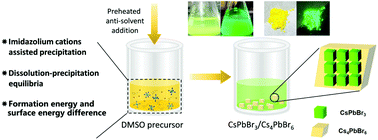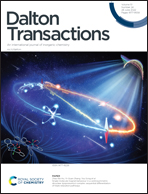Formation mechanisms of CsPbBr3/Cs4PbBr6 microscale composites assisted with imidazolium cations and their device applications†
Abstract
The instability of all-inorganic perovskite nanocrystals (NCs) remains a major challenge to their practical applications in displays and lighting. In order to improve their environmental resistance, highly luminescent CsPbBr3 NC embedded Cs4PbBr6 microcrystals (MCs) have been fabricated by an anti-solvent reprecipitation method with the assistance of 1-alkyl-3-methyl-imidazolium bromides. The heterostructure of the MCs is investigated in detail, and their formation mechanism is discussed in terms of the dissolution–precipitation equilibria and the total energy of variously scaled nanoparticles via density functional theory (DFT) calculations. Although the imidazolium ligands are not directly capping with the inner CsPbBr3 NCs, they are important to the formation of these MCs. The MCs exhibit better thermal resistance compared to conventional CsPbBr3 NCs prepared by the hot-injection method. Additionally, a prototype white light-emitting diode (WLED) was fabricated to demonstrate its practical application prospects. Thanks to the narrow emission bands and enhanced stability of the MCs, the WLED shows greater performance compared to bare perovskite NCs, indicating its great potential as a green phosphor in lighting and display applications.



 Please wait while we load your content...
Please wait while we load your content...